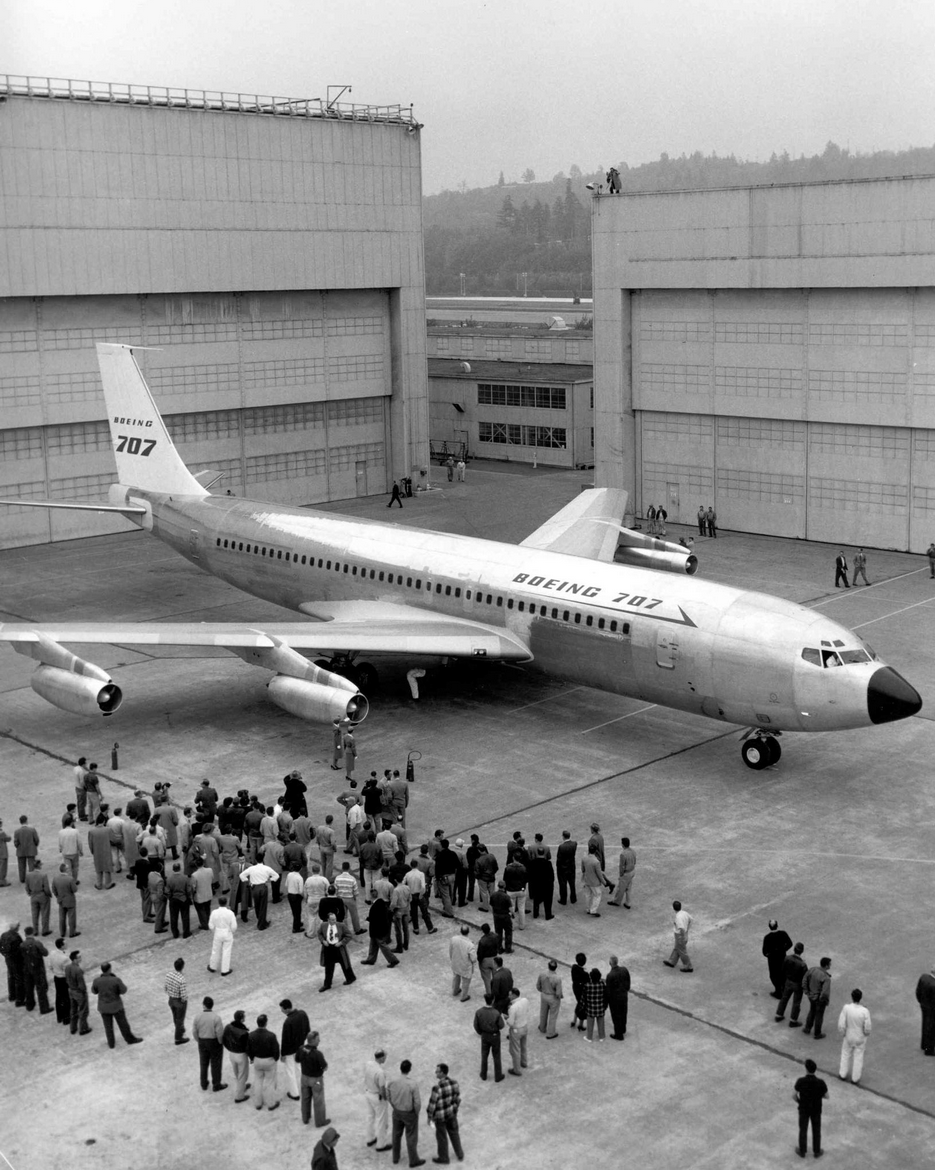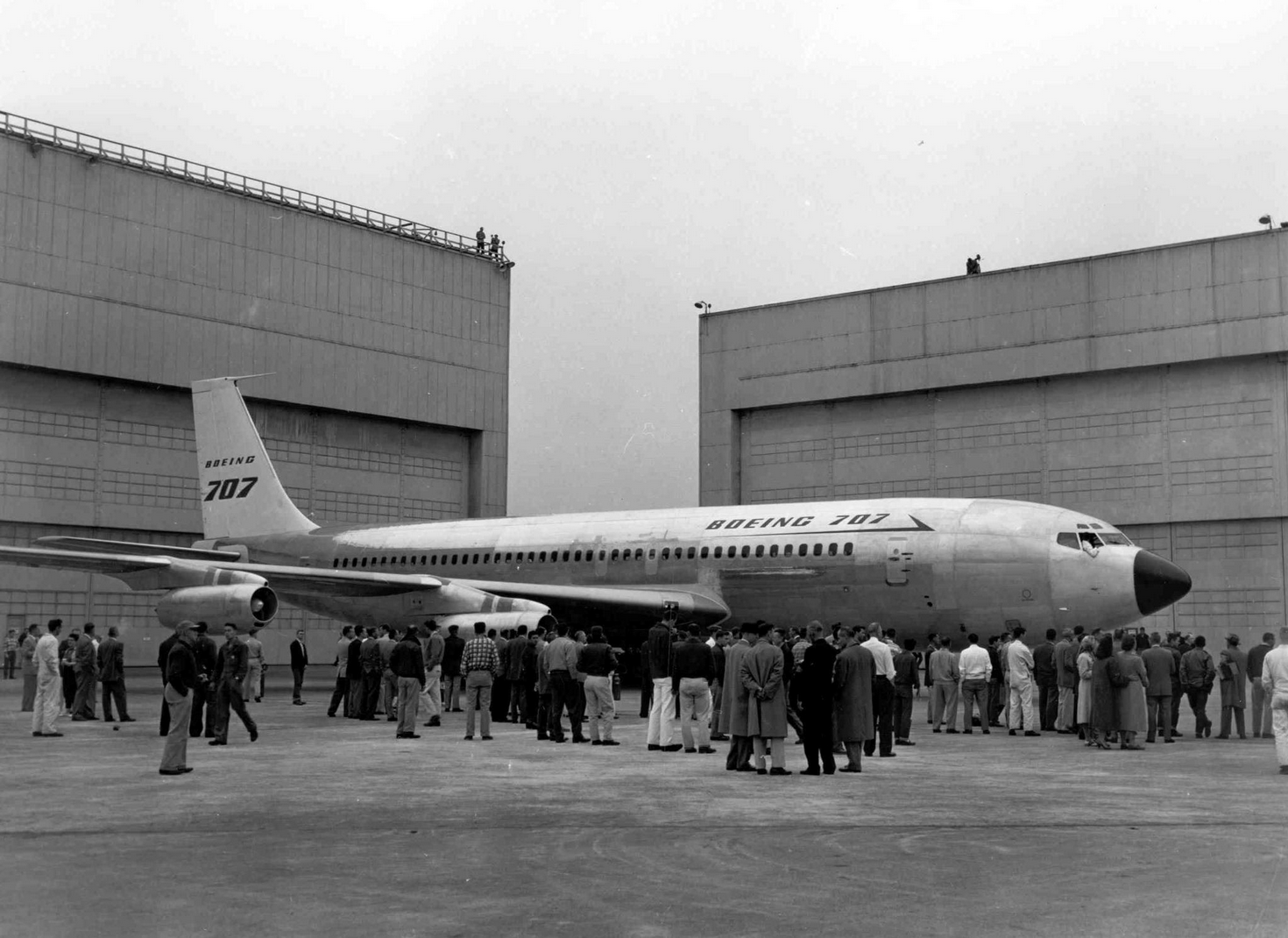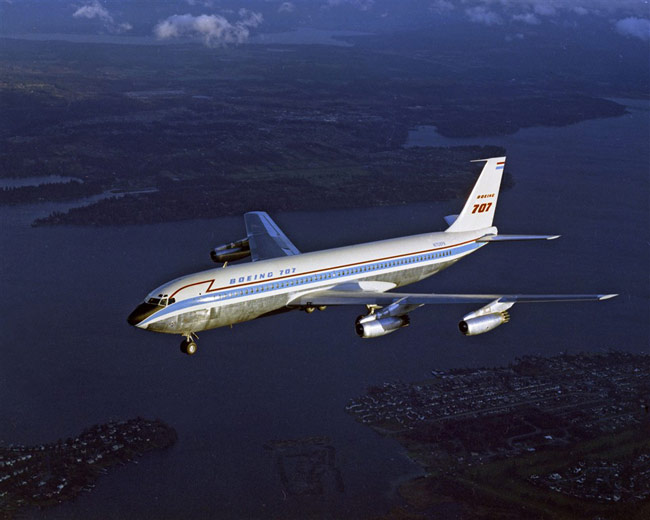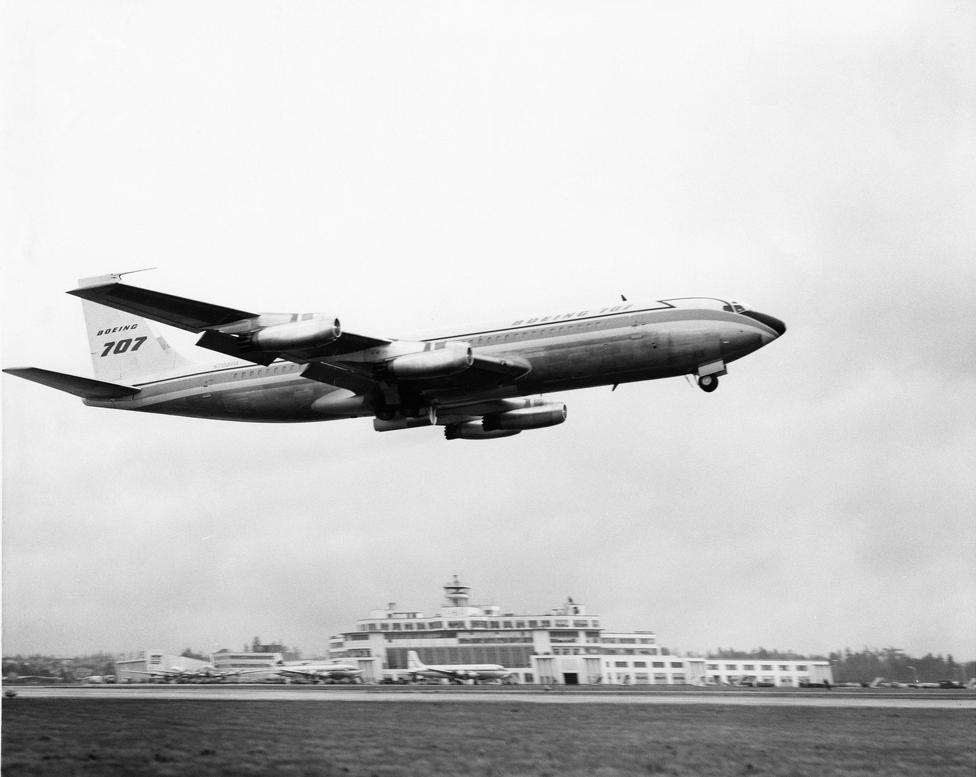

17586 was a Model 707-121. The new airliner had been sold to Pan American World Airways, the launch customer, as part of an order for twenty 707s in October 1955. The Federal Aviation Agency (FAA) assigned N708PA as its registration mark.

N708PA made its first flight 20 December 1957 with Boeing’s Chief of Flight Test, Alvin M. (“Tex”) Johnston. The airplane was initially used for flight and certification testing. Once this was completed, the new jet airliner was prepared for commercial service and delivered to Pan American at San Francisco International Airport (SFO), 30 November 1958. It was named Clipper Constitution.

In February 1965, the airliner was upgraded to 707-121B standards, which replaced the original turbojet engines with quieter, more efficient Pratt & Whitney Turbo Wasp JT3D-1 turbofan engines which produced 17,000 pounds of thrust. The wing inboard leading edges were modified to the design of the Model 720 and there was a longer horizontal tail plane.
Clipper Constitution flew for Pan Am for nearly 8 years, until 17 September 1965, when it crashed into Chances Peak, a 3,002 foot (915 meters) active stratovolcano on the Caribbean island of Montserrat. The point impact was 242 feet (74 meters) below the summit. All aboard, a crew of 9 and 21 passengers, were killed.

The Boeing Model 707-121 was a four-engine jet transport with swept wings and tail surfaces. The leading edge of the wings were swept at a 35° angle. The airliner had a flight crew of four: pilot, co-pilot, navigator and flight engineer.
The 707-121 was 145 feet, 1 inch (44.221 meters) long with a wing span of 130 feet, 10 inches (39.878 meters). The top of the vertical fin stood 42 feet, 5 inches (12.929 meters) high. The 707 pre-dated the ”wide-body” airliners, having a fuselage width of 12 feet, 4 inches (3.759 meters).

The airliner’s empty weight is 122,533 pounds (55,580 kilograms). Maximum take off weight is 257,000 pounds (116,573 kilograms). At MTOW, the 707 required 11,000 feet (3,353 meters) of runway to take off.
The 707-121 had a maximum speed is 540 knots (1,000 kilometers per hour). Its range was 2,800 nautical miles (5,186 kilometers).
The Boeing 707 was in production from 1958 to 1979. 1,010 were built. Production of military variants continued until 1994.
© 2018, Bryan R. Swopes
Start of the Jet Age? Have you not heard of the De Havilland Comet? First Commercial jet flight across the Atlantic
According to the Smithsonian Institution National Air and Space Museum, the “Jet Age” began in 1958. You are correct that the Comet flew in scheduled passenger service before the Boeing 707, but in only limited numbers. It wasn’t until the 707 entered service that airliners flying across the Atlantic Ocean carried more passengers than passenger ships. The 707 forever changed the way most people traveled long distances. The Comet did not. I stand by my statement.
Apparently the Vickers Viking with turbo jets was the the first jet powered aircraft to carry a fare paying passenger.
The aircraft was an experimental aircraft bu tI was told somebody actually paid to fly on it. Worth investigating.
Vickers Type 618 Viking VX856 (c/n 207) powered by two Rolls-Royce Nene I engines, first flight 6 April 1948 by test pilot Mutt Summers. It flew from London to Paris in 34 minutes, 7 seconds, 25 July 1948. Summers was in commmand, with George Robert Edwards CBE, the airplane’s chief designer, as copilot. Still searching for info re: the fare-paying passenger. Later registered G-AJBH and converted to reciprocating engines. Thanks for the suggestion, Ray.
That failed.
PW JT3C had a 3 stage turbine. ! hp and 2 LP turbines.
The feeling amongst us aeronautical engineers is that the Comet is kind of a bridge to the jet age. It did not take full advantage of the jet engine. The jet engine not only allows higher cruise speed, it also allows the engine’s high thrust to lift more weight off the runway. Just compare the size, passenger capacity, and cruise speed of the Comet with that of the Boeing 707 and Douglas DC-8. The Comet didn’t even match the passenger capacity of a DC-7 or a Constellation. Part of the success of the 707 and DC-8 must be attributed to Pan Am’s leader, Juan Trippe, who made Boeing and Douglas widen the cabin to accomodate four abreast in first-class and six in tourist. Pan Am also ordered 24 DC-8’s to support both Boeing and Douglas. The wider cabins gave both aircraft a spacious, modern feeling that many other jets of the area lacked. I think most of us agree that the 707 is the airplane that truly ushered in the age of commercial jet transport.
Thank you, Rick. That’s an interesting analysis.
The Boeing 707 ushered in trans-continental, trans-oceanic commercial airline travel, but the Douglas DC-8 was the first to exceed Mach 1. Had the DC-8 come out a bit sooner, the DC-8 may have reigned supreme in launch customer jetliner travel, as it was, the 707 was upgraded many times to make it very applicable to domestic and foreign customers. I flew on both, for narrow-body jetliners, only the 727 exceeds production totals.
My favorite aeronautical comeback was made between a BOAC Comet over the Canadian coast coming in from the U.K. and a Pan Am 707 departing for Europe . The 707 was climbing out at 18,000 ft. The Comet was still at 30,000 when he came on and asked the 707, “What are you doing way down there at 18k” Answer. “Mach .82. What are you doing?” There was no answer. Confirmed the disparity between the two aircraft.
You noted that first flight was on December 20th but the photo caption says the photo was taken during the second flight which was also noted as on December 20th. Did they actually fly twice in one day or is the photo caption in error?
“Production of military variants continued until 1994.”
My first 10 years of USAF career was with US & NATO E-3s. One of my E-3 friends went to the JSTARS program office when it was still building up a fleet based on used 707 airframes modified to the E-8 configuration. He told me when Boeing wanted to shutdown the 707 production line, they notified the USAF but offered to keep it open if USAF would pay (a lot) for it. Instead the JSTARS bought the last brand new 707 produced and traded it to a foreign airline for five used 707s.